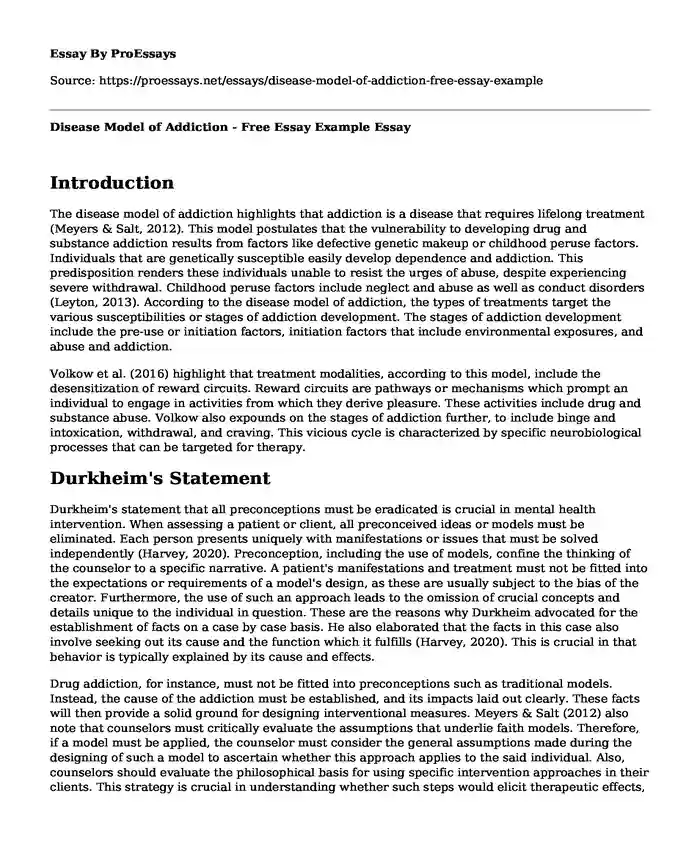Introduction
The disease model of addiction highlights that addiction is a disease that requires lifelong treatment (Meyers & Salt, 2012). This model postulates that the vulnerability to developing drug and substance addiction results from factors like defective genetic makeup or childhood peruse factors. Individuals that are genetically susceptible easily develop dependence and addiction. This predisposition renders these individuals unable to resist the urges of abuse, despite experiencing severe withdrawal. Childhood peruse factors include neglect and abuse as well as conduct disorders (Leyton, 2013). According to the disease model of addiction, the types of treatments target the various susceptibilities or stages of addiction development. The stages of addiction development include the pre-use or initiation factors, initiation factors that include environmental exposures, and abuse and addiction.
Volkow et al. (2016) highlight that treatment modalities, according to this model, include the desensitization of reward circuits. Reward circuits are pathways or mechanisms which prompt an individual to engage in activities from which they derive pleasure. These activities include drug and substance abuse. Volkow also expounds on the stages of addiction further, to include binge and intoxication, withdrawal, and craving. This vicious cycle is characterized by specific neurobiological processes that can be targeted for therapy.
Durkheim's Statement
Durkheim's statement that all preconceptions must be eradicated is crucial in mental health intervention. When assessing a patient or client, all preconceived ideas or models must be eliminated. Each person presents uniquely with manifestations or issues that must be solved independently (Harvey, 2020). Preconception, including the use of models, confine the thinking of the counselor to a specific narrative. A patient's manifestations and treatment must not be fitted into the expectations or requirements of a model's design, as these are usually subject to the bias of the creator. Furthermore, the use of such an approach leads to the omission of crucial concepts and details unique to the individual in question. These are the reasons why Durkheim advocated for the establishment of facts on a case by case basis. He also elaborated that the facts in this case also involve seeking out its cause and the function which it fulfills (Harvey, 2020). This is crucial in that behavior is typically explained by its cause and effects.
Drug addiction, for instance, must not be fitted into preconceptions such as traditional models. Instead, the cause of the addiction must be established, and its impacts laid out clearly. These facts will then provide a solid ground for designing interventional measures. Meyers & Salt (2012) also note that counselors must critically evaluate the assumptions that underlie faith models. Therefore, if a model must be applied, the counselor must consider the general assumptions made during the designing of such a model to ascertain whether this approach applies to the said individual. Also, counselors should evaluate the philosophical basis for using specific intervention approaches in their clients. This strategy is crucial in understanding whether such steps would elicit therapeutic effects, despite being recommended by pioneers in the field.
Conclusion
Therefore, the disease model supports the use of medical approaches to target the various neurobiologic circuitry involved in addiction development to treat this ailment. These interventions can also be designed to target behavioral manifestations or susceptibilities to addiction Volkow et al., 2016). One of such approaches is the use of behavioral therapy to target faulty brain circuitry, to replace deleterious rewards of drugs with healthier rewards such as social contact.
References
Harvey, L. (2020). Social research glossary. Quality Research International. https://www.qualityresearchinternational.com/socialresearch/durkheim.htm#:~:text=For%20Durkheim%2C%20the%20first%20and,must%20be%20focused%20on%20facts.
Leyton, M. (2013). Are addictions diseases or choices? Journal of Psychiatry & Neuroscience: JPN, 38(4), 219. https://www.ncbi.nlm.nih.gov/pmc/articles/PMC3692718/
Myers, P.L. & Salt, N.R. (2012). Becoming an addictions counselor: a comprehensive text (3rd ed.). Jones & Bartlett. ISBN: 978-1449673000.
Volkow, N. D., Koob, G. F., & McLellan, A. T. (2016). Neurobiologic advances from the brain disease model of addiction. New England Journal of Medicine, 374(4), 363-371. https://www.ncbi.nlm.nih.gov/pmc/articles/PMC6135257/.
Cite this page
Disease Model of Addiction - Free Essay Example. (2024, Jan 11). Retrieved from https://proessays.net/essays/disease-model-of-addiction-free-essay-example
If you are the original author of this essay and no longer wish to have it published on the ProEssays website, please click below to request its removal:
- Inferential Statistics
- Living in the Shadows of Domestic Violence Essay
- Stress and Burnout in Nursing Essay Example
- Excessive Alcohol Use: A Life-Threatening Disaster - Essay Sample
- Ensuring Quality, Safety & Privacy: HIPAA & HITECH in Healthcare - Research Paper
- COPD & Emphysema: Lung Resistance & Compliance - Essay Sample
- Free Paper Sample: HIV/AIDS Cases in Nigeria







